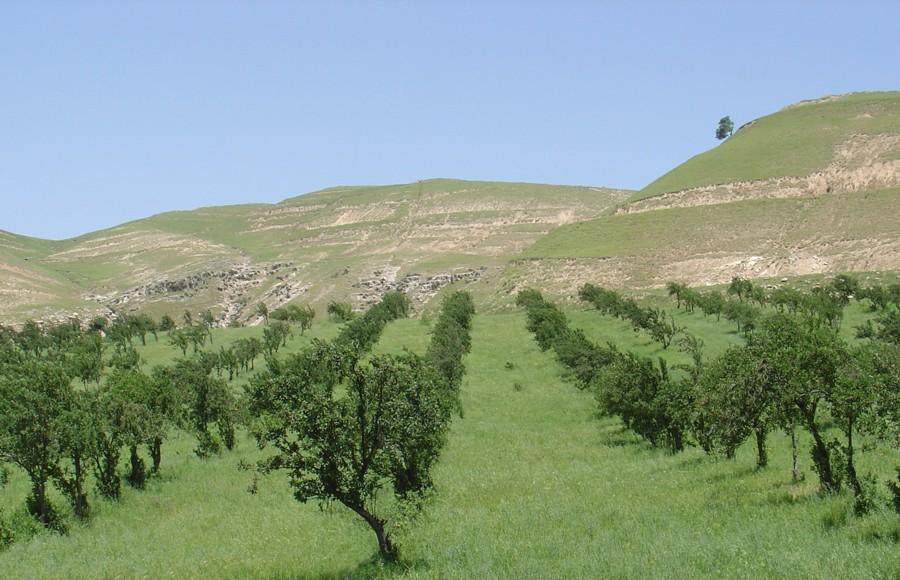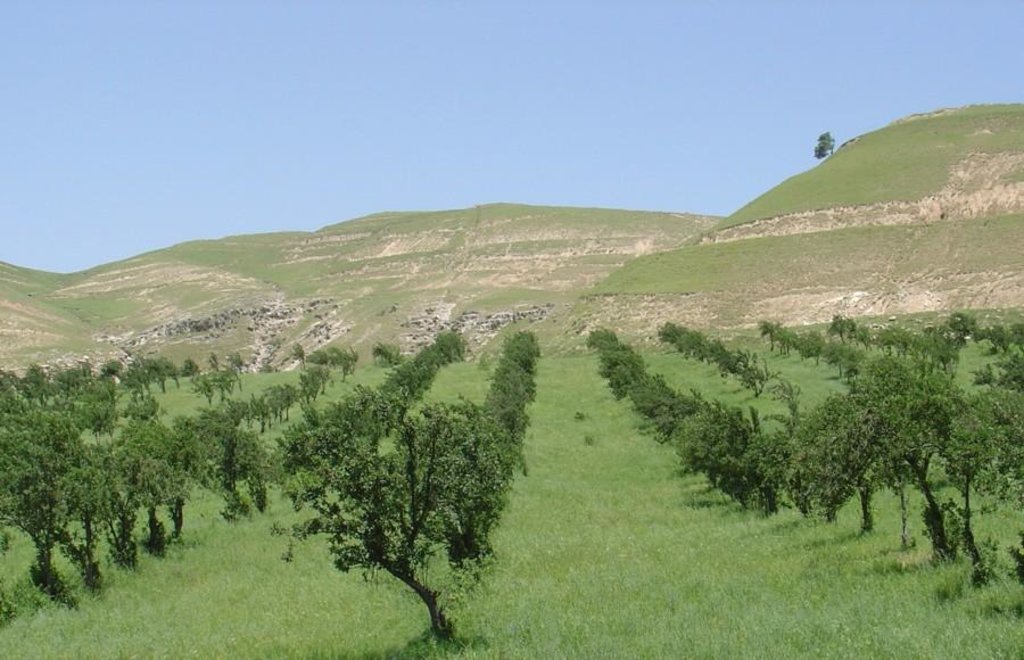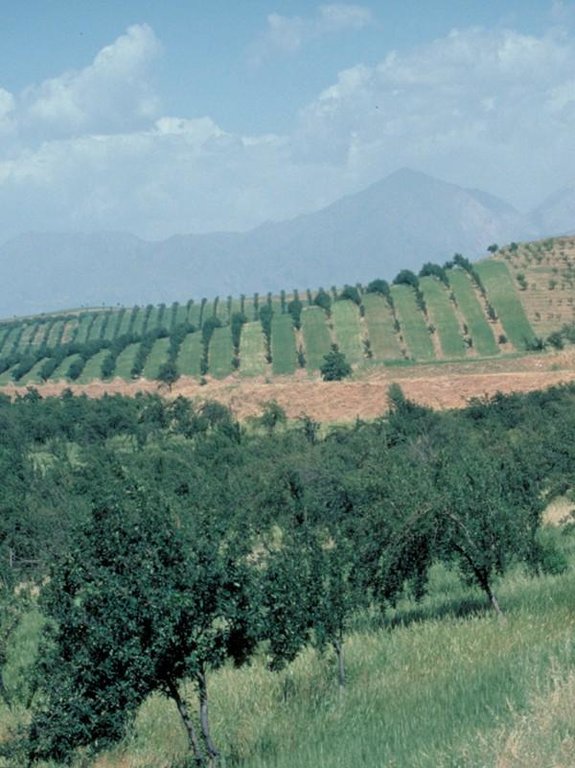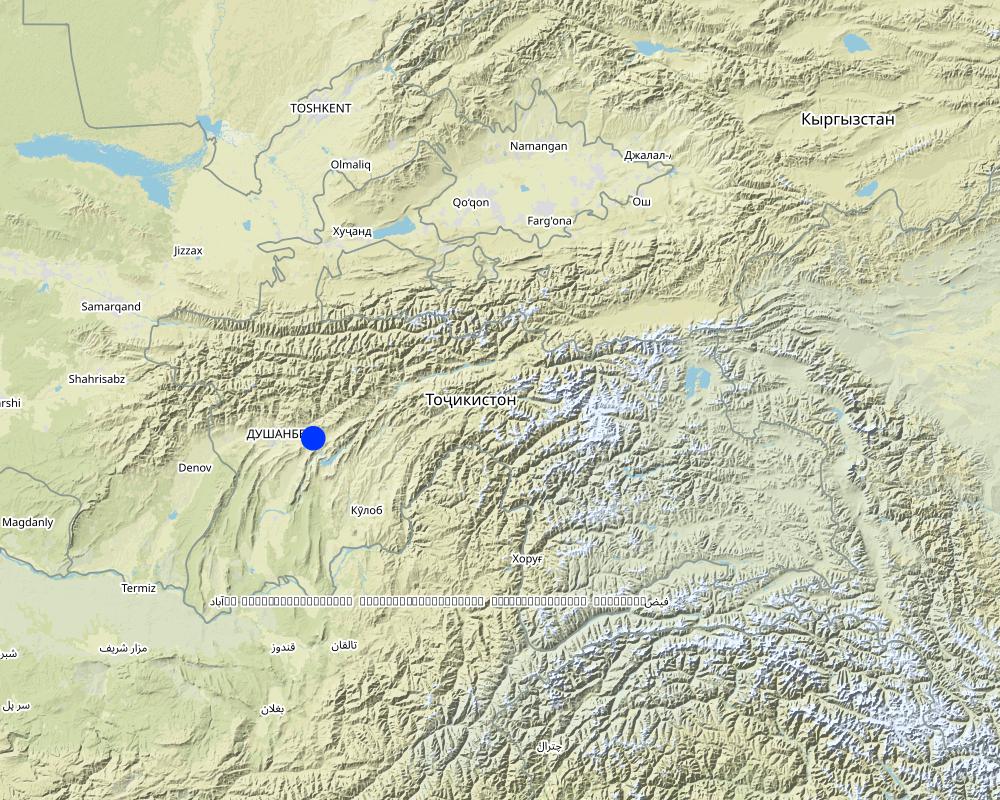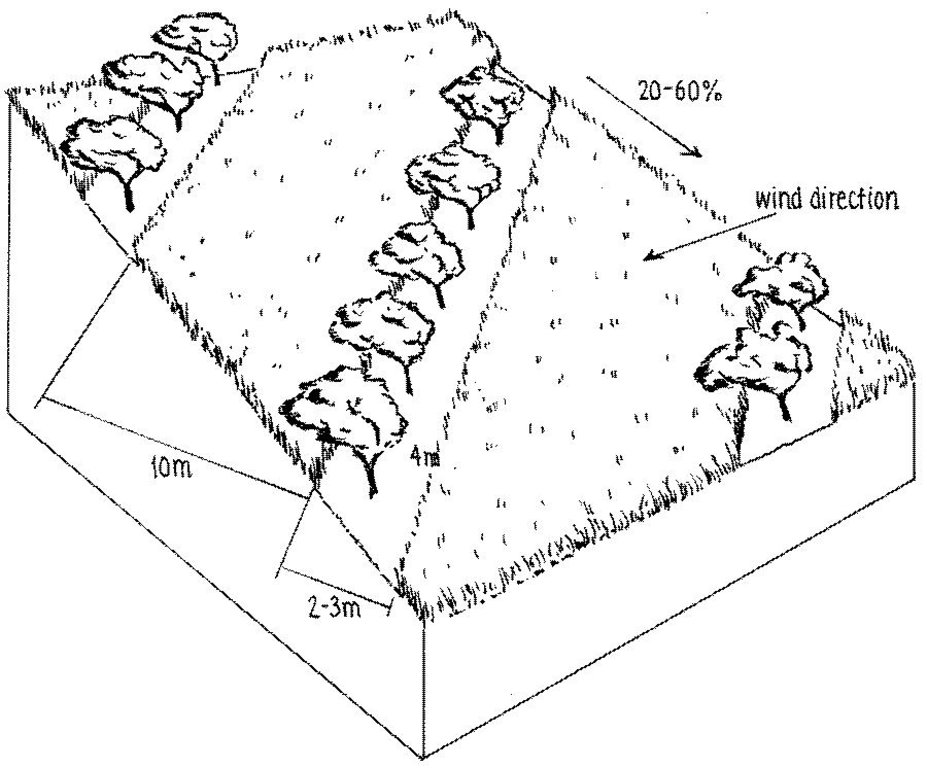Orchard-based agroforestry [Tajiquistão]
- Criação:
- Atualização:
- Compilador/a: Loes Masselink
- Editor: –
- Revisores: Deborah Niggli, Alexandra Gavilano, David Streiff, Lisa Soloveva, Olga Andreeva, Laura Ebneter, Joana Eichenberger
technologies_1017 - Tajiquistão
- Resumo completo em PDF
- Resumo completo em PDF para impressão
- Resumo completo no navegador
- Resumo completo (sem formatação)
- Orchard-based agroforestry: 14 de Agosto de 2019 (inactive)
- Orchard-based agroforestry: 2 de Novembro de 2021 (public)
- Orchard-based agroforestry: 4 de Abril de 2018 (inactive)
- Orchard-based agroforestry: 19 de Julho de 2017 (inactive)
- Orchard-based agroforestry: 17 de Julho de 2017 (inactive)
- Orchard-based agroforestry: 17 de Julho de 2017 (inactive)
- Orchard-based agroforestry: 17 de Julho de 2017 (inactive)
- Orchard-based agroforestry: 9 de Março de 2017 (inactive)
Veja as seções
Expandir tudo Recolher tudo1. Informação geral
1.2 Detalhes do contato das pessoas capacitadas e instituições envolvidas na avaliação e documentação da tecnologia
Especialista em GST:
Nome do projeto que facilitou a documentação/avaliação da Tecnologia (se relevante)
Book project: where the land is greener - Case Studies and Analysis of Soil and Water Conservation Initiatives Worldwide (where the land is greener)Nome do projeto que facilitou a documentação/avaliação da Tecnologia (se relevante)
Pilot Program for Climate Resilience, Tajikistan (WB / PPCR)Nome da(s) instituição(ões) que facilitou(ram) a documentação/ avaliação da Tecnologia (se relevante)
CDE Centre for Development and Environment (CDE Centre for Development and Environment) - SuíçaNome da(s) instituição(ões) que facilitou(ram) a documentação/ avaliação da Tecnologia (se relevante)
Soil Science Institute (Soil Science Institute) - Tajiquistão1.3 Condições em relação ao uso da informação documentada através de WOCAT
O compilador e a(s) pessoa(s) capacitada(s) aceitam as condições relativas ao uso de dados documentados através do WOCAT:
Sim
1.5 Referência ao(s) questionário(s) sobre abordagens GST (documentado(s) usando WOCAT)
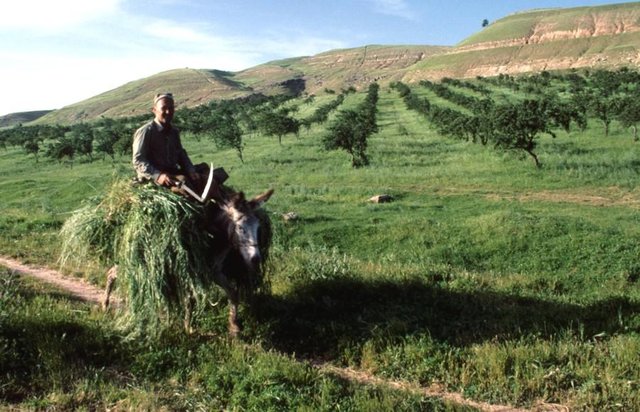
Transition from a centralised regime to a local … [Tajiquistão]
A land use system established during the previous authoritarian regime of the Soviet Union is now being adapted to the farmers' needs via their own initiative.
- Compilador/a: Sanginboy Sanginov
2. Descrição da tecnologia de GST
2.1 Descrição curta da tecnologia
Definição da tecnologia:
An agroforestry system where legumes and cereals are planted in fruit orchards, giving simultaneous production and conservation benefits.
2.2 Descrição detalhada da tecnologia
Descrição:
In the Faizabad region, Tajikistan, an area which is characterised by hilly topography, and deep but highly erodible loess soils, farmers traditionally cultivate beans and wheat in combination with fruit trees. This was a rather unsystematic agroforestry system, and during Soviet times (in the 1980s) fruit production was intensified. Pure-stand orchards were established: the land was levelled and on slopes exceeding 20%, terraces were constructed mechanically. The density of trees was increased, and the little space remaining between was used for hay production. Annual cropping was stopped.
Purpose of the Technology: After the Soviet era, farmers reduced the number of trees, allowing room for inter-cropping. They also established new orchards according to this same pattern. Those who farm rented land merely inter crop wheat, whereas the few farmers who own their land, rotate crops with two years of wheat, followed by one of legumes (beans or lucern). Crops are grown both for home consumption and sale.
Establishment / maintenance activities and inputs: The density of apples was reduced by expanding the spacing from approx 5 m to 10 m between rows, and from 2 m to 4 m within rows. Along each row of trees a 2-3 m strip of grass was left to grow. The layout of fruit trees in lines is a compromise between being along the contour, and against the prevailing wind. After harvesting of the fruit, between August and October, farmers sow their annual crops.
Natural / human environment: This agroforestry system provides protection against strong winds, heavy rains and flooding. Soil erosion (by water) has been reduced due to improved soil cover by the inter cropping, and through leaf litter, which is left to decompose on the ground. Furthermore, after harvesting, about three quarters of the crop residues are left on the field as mulch. The remainder is used as fodder. Soil organic matter within the current agroforestry system is considerably higher than in the surrounding grazing areas. Soil fertility has improved also: beans can fix 60-80 kg/ha/year of nitrogen. Compared with other crops, wheat provides the best erosion protection. Since the lateral rooting system of the apple trees reaches only 1-1.5 m from the trunk, competition for nutrients is not a major problem. Neither is there a problem with shade, since during the crop establishment period the trees have lose their leaves. In order to increase production, farmers plan to apply supplementary irrigation where possible.
2.3 Fotos da tecnologia
2.5 País/região/locais onde a tecnologia foi aplicada e que estão cobertos nesta avaliação
País:
Tajiquistão
Região/Estado/Província:
Tajikistan, Faizabad
Especificação adicional de localização:
Faizabad
Comentários:
Total area covered by the SLM Technology is 45 km2.
Map
×2.6 Data da implementação
Caso o ano exato seja desconhecido, indique a data aproximada:
- 10-50 anos atrás
2.7 Introdução da tecnologia
Especifique como a tecnologia foi introduzida:
- atráves de inovação dos usuários da terra
3. Classificação da tecnologia de GST
3.1 Principal/principais finalidade(s) da tecnologia
- Reduz, previne, recupera a degradação do solo
3.2 Tipo(s) atualizado(s) de uso da terra onde a tecnologia foi aplicada
Uso do solo misturado dentro da mesma unidade de terra:
Sim
Especificar o uso misto da terra (culturas/ pastoreio/ árvores):
- Agrofloresta

Terra de cultivo
- Cultura anual
- Cultura de árvores e arbustos
Cultivo anual - Especificar culturas:
- Legumes e leguminosas - feijão
- cereais - trigo (primavera)
- lucerne
Cultivo de árvores e arbustos - Especificar culturas:
- frutas de pomóideas (maçãs, peras, marmelos, etc.)
Comentários:
Major land use problems (compiler’s opinion): Most of the rains fall in late autumn and early spring, and the rains coincide with very strong winds. The topsoil is therefore exposed to erosion during this period if left uncovered, and without a windbreak. A particular problem during the soviet period was that the intensive orchard system meant annual food crops were left out of the production system: soil cover was reduced and there was less food.
Type of cropping system and major crops comments: two years of wheat followed by one of legumes (beans or lucerne)
3.4 Abastecimento de água
Abastecimento de água para a terra na qual a tecnologia é aplicada:
- Precipitação natural
3.5 Grupo de GST ao qual pertence a tecnologia
- Agrofloresta
- Quebra-vento/cerca de árvores
- Solo/cobertura vegetal melhorada
3.6 Medidas de GST contendo a tecnologia

Medidas agronômicas
- A2: Matéria orgânica/fertilidade do solo
- A7: Outros

Medidas vegetativas
- V1: cobertura de árvores/arbustos
- V2: gramíneas e plantas herbáceas perenes

Medidas estruturais
- S1: Terraços
Comentários:
Main measures: agronomic measures, vegetative measures, structural measures
Type of agronomic measures: mulching, rotations / fallows
Type of vegetative measures: aligned: -against wind
3.7 Principais tipos de degradação da terra abordados pela tecnologia

Erosão do solo pela água
- Wt: Perda do solo superficial/erosão de superfície
- Wg: Erosão por ravinas/ravinamento

Erosão do solo pelo vento
- Et: Perda do solo superficial

Deteriorização química do solo
- Cn: declínio de fertilidade e teor reduzido de matéria orgânica (não causado pela erosão)
Comentários:
Main type of degradation addressed: Wt: loss of topsoil / surface erosion, Wg: gully erosion / gullying, Et: loss of topsoil, Cn: fertility decline and reduced organic matter content
Main causes of degradation: other human induced causes (specify) (The suplementary irrigation system could not be maintained after state farms stopped recieving government support. Thus, it became more interesting to increase crop production through intercropping.)
Secondary causes of degradation: governance / institutional (With the transformation of the planned economy to a market economy, for the state farm areas new forms of management had to be found.)
3.8 Redução, prevenção ou recuperação da degradação do solo
Especifique o objetivo da tecnologia em relação a degradação da terra:
- Prevenir degradação do solo
Comentários:
Main goals: prevention of land degradation
4. Especificações técnicas, implementação de atividades, entradas e custos
4.1 Desenho técnico da tecnologia
Especificações técnicas (relacionada ao desenho técnico):
Fruit trees intercropped with wheat (or beans): note the fruit trees are aligned in a 'compromise' position between the direction of the prevailing wind and the slope.
Location: Faizabad. Faizabad, Tajikistan
Date: 25-07-2004
Technical knowledge required for field staff / advisors: moderate
Technical knowledge required for land users: moderate
Main technical functions: improvement of ground cover, increase in nutrient availability (supply, recycling,…), reduction in wind speed, improvement of soil fertility (with crop rotation incl. Beans+lucerne)
Secondary technical functions: control of concentrated runoff: retain / trap, reduction of slope angle, improvement of subsoil structure (hardpan), water harvesting / increase water supply, retain/trap concentrated runoff (prevention of gully erosion)
Mulching
Material/ species: leaf litter, crop residues
Rotations / fallows
Material/ species: wheat, legumes
Aligned: -against wind
Vegetative material: T : trees / shrubs, G : grass
Vertical interval between rows / strips / blocks (m): 2-6
Spacing between rows / strips / blocks (m): 10
Vertical interval within rows / strips / blocks (m): 4
Width within rows / strips / blocks (m): 2-3
Slope (which determines the spacing indicated above): 20-60%
terrace: forward sloping: earth
Autor:
Mats Gurtner, Centre for Development and Environment (CDE), University of Bern
4.2 Informação geral em relação ao cálculo de entradas e custos
Especifique a moeda utilizada para os cálculos de custo:
- USD
4.3 Atividades de implantação
| Atividade | Periodicidade (estação do ano) | |
|---|---|---|
| 1. | Planting of fruit orchard | |
| 2. | Thinning: doubling the spacing between trees (by farmers, after Soviet period) | |
| 3. | Hand planting of fruit tree seedlings | |
| 4. | planting fruit trees | |
| 5. | 1. Levelling of steep land into terraces with graders | |
| 6. | Planting of fruit orchards |
4.4 Custos e entradas necessárias para a implantação
| Especifique a entrada | Unidade | Quantidade | Custos por unidade | Custos totais por entrada | % dos custos arcados pelos usuários da terra | |
|---|---|---|---|---|---|---|
| Mão-de-obra | Planting of fruit orchard | ha | 1,0 | 60,0 | 60,0 | 100,0 |
| Mão-de-obra | Thinning and hand lanting | ha | 2,0 | 10,0 | 20,0 | 100,0 |
| Equipamento | machine use | ha | 1,0 | 120,0 | 120,0 | 100,0 |
| Equipamento | tools | 1,0 | 10,0 | 10,0 | 100,0 | |
| Material vegetal | seedlings | ha | 1,0 | 250,0 | 250,0 | |
| Fertilizantes e biocidas | fertilizer | ha | 1,0 | 50,0 | 50,0 | 100,0 |
| Fertilizantes e biocidas | biocides | ha | 1,0 | 30,0 | 30,0 | 100,0 |
| Fertilizantes e biocidas | pesticides | ha | 1,0 | 30,0 | 30,0 | 100,0 |
| Custos totais para a implantação da tecnologia | 570,0 | |||||
| Custos totais para o estabelecimento da Tecnologia em USD | 570,0 | |||||
4.5 Atividades recorrentes/manutenção
| Atividade | Periodicidade/frequência | |
|---|---|---|
| 1. | Applying organic manure for crops and trees | (November to March) |
| 2. | Ploughing to depth of 25–30 cm for annual crops | (November to March) |
| 3. | Disc ploughing and harrowing . | (March) |
| 4. | Chemical fertiliser application to crops | (once during season). |
| 5. | Pest management with chemicals | (two-three times where possible/affordable) |
| 6. | harvesting: wheat is the only crop, which can be harverted if tractor and petrol is available | |
| 7. | mulching trees (humus cover) | |
| 8. | cutting trees |
4.6 Custos e entradas necessárias pata a manutenção/atividades recorrentes (por ano)
| Especifique a entrada | Unidade | Quantidade | Custos por unidade | Custos totais por entrada | % dos custos arcados pelos usuários da terra | |
|---|---|---|---|---|---|---|
| Mão-de-obra | applying organic manure for crops and trees | ha | 1,0 | 45,0 | 45,0 | 100,0 |
| Mão-de-obra | ploughing | ha | 2,0 | 10,0 | 20,0 | 100,0 |
| Equipamento | labour animal traction | ha | 1,0 | 10,0 | 10,0 | 100,0 |
| Equipamento | labour harvesting | ha | 1,0 | 100,0 | ||
| Equipamento | labour mulching and cutting | ha | 1,0 | 50,0 | 50,0 | 100,0 |
| Material vegetal | seeds | ha | 1,0 | 30,0 | 30,0 | 100,0 |
| Fertilizantes e biocidas | fertilizer | ha | 1,0 | 50,0 | 50,0 | 100,0 |
| Fertilizantes e biocidas | biocides | ha | 1,0 | 5,0 | 5,0 | 100,0 |
| Fertilizantes e biocidas | compost manure | ha | 1,0 | 10,0 | 10,0 | 100,0 |
| Custos totais para a manutenção da tecnologia | 220,0 | |||||
| Custos totais de manutenção da Tecnologia em USD | 220,0 | |||||
Comentários:
Cost calculation refers to farmers who established new agroforestry plots (without receiving any incentives). These are farmers who have rented land from state farms. However, conversion of Soviet orchards is more common than the establishment of new agroforestry plots (information on costs not available).
5. Ambiente natural e humano
5.1 Clima
Precipitação pluviométrica anual
- <250 mm
- 251-500 mm
- 501-750 mm
- 751-1.000 mm
- 1.001-1.500 mm
- 1.501-2.000 mm
- 2.001-3.000 mm
- 3.001-4.000 mm
- > 4.000 mm
Zona agroclimática
- Semiárido
Thermal climate class: temperate
5.2 Topografia
Declividade média:
- Plano (0-2%)
- Suave ondulado (3-5%)
- Ondulado (6-10%)
- Moderadamente ondulado (11-15%)
- Forte ondulado (16-30%)
- Montanhoso (31-60%)
- Escarpado (>60%)
Formas de relevo:
- Planalto/planície
- Cumes
- Encosta de serra
- Encosta de morro
- Sopés
- Fundos de vale
Zona de altitude:
- 0-100 m s.n.m.
- 101-500 m s.n.m.
- 501-1.000 m s.n.m.
- 1.001-1.500 m s.n.m.
- 1.501-2.000 m s.n.m.
- 2.001-2.500 m s.n.m.
- 2.501-3.000 m s.n.m.
- 3.001-4.000 m s.n.m.
- > 4.000 m s.n.m.
Indique se a tecnologia é aplicada especificamente em:
- Não relevante
Comentários e outras especificações sobre a topografia:
Landforms also mountain slopes.
5.3 Solos
Profundidade do solo em média:
- Muito raso (0-20 cm)
- Raso (21-50 cm)
- Moderadamente profundo (51-80 cm)
- Profundo (81-120 cm)
- Muito profundo (>120 cm)
Textura do solo (solo superficial):
- Médio (limoso, siltoso)
Matéria orgânica do solo superficial:
- Baixo (<1%)
Caso disponível anexe a descrição completa do solo ou especifique as informações disponíveis, p. ex. tipo de solo, PH/acidez do solo, nitrogênio, capacidade de troca catiônica, salinidade, etc.
Soil fertility: low
Soil drainage / infiltration: good
Soil water storage capacity: medium
5.4 Disponibilidade e qualidade de água
Lençol freático:
< 5 m
Disponibilidade de água de superfície:
Precário/nenhum
Qualidade da água (não tratada):
Água potável boa
5.5 Biodiversidade
Diversidade de espécies:
- Alto
5.6 Características dos usuários da terra que utilizam a tecnologia
Orientação de mercado do sistema de produção:
- misto (subsistência/comercial)
Rendimento não agrícola:
- >50% de toda renda
Nível de mecanização:
- Trabalho manual
- Mecanizado/motorizado
Indique outras características relevantes dos usuários da terra:
Off-farm income specification: trade and business; young men often migrate to Russia (seasonally or for several years) to search for jobs
Level of mechanization manual work: pruning of trees, harvesting, applying herbizids
Level of mechanization animal traction: ploughing if no fuel for tractors is available
Level of mechanization mechanized/motorized: Disc ploughing and harrowing, if petrol is available
5.7 Área média de terrenos utilizados pelos usuários de terrenos que aplicam a Tecnologia
- < 0,5 ha
- 0,5-1 ha
- 1-2 ha
- 2-5 ha
- 5-15 ha
- 15-50 ha
- 50-100 ha
- 100-500 ha
- 500-1.000 ha
- 1.000-10.000 ha
- > 10.000 ha
É considerado pequena, média ou grande escala (referente ao contexto local)?
- Pequena escala
Comentários:
Average area of land owned or leased by land users applying the Technology also 2-5 ha
5.8 Propriedade de terra, direitos de uso da terra e de uso da água
Propriedade da terra:
- Estado
Direitos do uso da terra:
- Arrendado
5.9 Acesso a serviços e infraestrutura
Saúde:
- Pobre
- Moderado
- Bom
Educação:
- Pobre
- Moderado
- Bom
Assistência técnica:
- Pobre
- Moderado
- Bom
Energia:
- Pobre
- Moderado
- Bom
Vias e transporte:
- Pobre
- Moderado
- Bom
6. Impactos e declarações finais
6.1 Impactos no local mostrados pela tecnologia
Impactos socioeconômicos
Produção
Produção agrícola
Produção de forragens
Produção de madeira
Renda e custos
Rendimento agrícola
Outros impactos socioeconômicos
trees hinder farm operations
Comentários/especificar:
difficult to apply pesticides using machinery and pesticides are very expensive.
Pruning is important, but farmers are new to the system and don’t always have the skills required
Impactos socioculturais
Instituições comunitárias
Atenuação de conflitos
Impactos ecológicos
Ciclo hídrico/escoamento
Drenagem de excesso de água
Solo
Umidade do solo
Cobertura do solo
Perda de solo
Matéria orgânica do solo/carbono abaixo do solo
Clima e redução de riscos de desastre
Velocidade do vento
Outros impactos ecológicos
nutrient use efficiency
water use efficiency
soil fertility
Comentários/especificar:
Also biodiversity enhancement is medium (20-50%)
6.2 Impactos externos mostrados pela tecnologia
Caudal confiável e estável em período seco
Cheias de jusante
Sedimentação a jusante
Poluição de água subterrânea/rio
Sedimentos transportados pelo vento
6.4 Análise do custo-benefício
Como os benefícios se comparam aos custos de implantação (do ponto de vista dos usuários da terra)?
Retornos a curto prazo:
positivo
Retornos a longo prazo:
muito positivo
Como os benefícios se comparam aos custos recorrentes/de manutenção(do ponto de vista dos usuários da terra)?
Retornos a curto prazo:
muito positivo
Retornos a longo prazo:
muito positivo
6.5 Adoção da tecnologia
- 11-50%
Se disponível, determine a quantidade (número de unidades familiares e/ou área abordada):
3500 land user families have adopted the Technology without any external material support in an area of 45 km^2
De todos aqueles que adotaram a Tecnologia, quantos o fizeram espontaneamente, ou seja, sem receber nenhum incentivo/ pagamento material?
- 91-100%
Comentários:
3500 land user families have adopted the Technology without any external material support
There is a strong trend towards spontaneous adoption of the Technology
Comments on adoption trend: Adoption rate is high: 3,500 households in the region, who rented the orchards, have converted them themselvs without any incentives.
6.7 Pontos fortes/vantagens/oportunidades da tecnologia
| Pontos fortes/vantagens/oportunidades na visão do compilador ou de outra pessoa capacitada |
|---|
|
Easy to convert orchards How can they be sustained / enhanced? Land reform from state to private ownership would assist the process and strengthen farmers' associations. |
| Helps provide employment (mainly self- employment, partial employment of additional labourers) and increased self-sufficiency. With the cultivation of wheat, some farmers can solve their food problems and do not need an off-farm income. |
|
Improvement of soil fertility and soil organic matter content How can they be sustained / enhanced? Use all the crop residue and leaves of trees as cover (mulch). |
|
Considerable reduction of soil erosion How can they be sustained / enhanced? Adopt cover crop and rotate with other legumes and minimum tillage system. |
|
Wider spacing between the rows of trees (to 10 m) is best for the agroforestry How can they be sustained / enhanced? Remaining orchards with the original Soviet spacing of 5m between the rows should be thinned. |
6.8 Pontos fracos, desvantagens/riscos da tecnologia e formas de superá-los
| Pontos fracos/vantagens/riscos na visão do compilador ou de outra pessoa capacitada | Como eles podem ser superados? |
|---|---|
| The irrigation system established during Soviet times required high maintenance inputs due to siltation of the canals. During the period of the civil war systems ceased to function, the canals filled up with sediments and finally overflowed during rain storms causing gully formation | Control of water flow within the orchard using cutoff drains and drainage ditches. |
| Lines of trees which are planted up and down the slope to provide wind. | Compromise in layout design (see description). |
| Orchards managed by state farms are often not well looked after. | Leasing of land and awarding landholder certificates leads to improved orchard management. |
7. Referências e links
7.1 Métodos/fontes de informação
7.3 Links para informações on-line relevantes
Título/ descrição:
Loes Masselink. 2012. Monitoring SLM Practices in Tajikistan. BSc thesis, Land Degradation and Development Group, International Land and Water Management at Wageningen University. The Netherlands.
URL:
https://www.wocat.net/fileadmin/user_upload/documents/Theses/Masselink2012.pdf
Links e módulos
Expandir tudo Recolher tudoLinks

Transition from a centralised regime to a local … [Tajiquistão]
A land use system established during the previous authoritarian regime of the Soviet Union is now being adapted to the farmers' needs via their own initiative.
- Compilador/a: Sanginboy Sanginov
Módulos
Não há módulos


